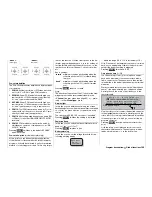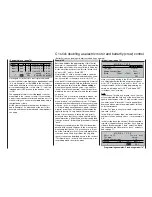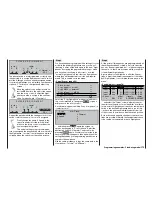
163
pending on the information you have entered in the
»
Model type
« menu. Since in this section we are
dealing with a model fi tted with only two wing-moun-
ted servos, the multi-fl ap menu (described in the sec-
tion starting on page 116) is not available. For this re-
ason we begin with the sub-menu …
»Brake settings«
B R A K E S E T T I N G S
off
If the above message appears, then your model is
equipped with a motor, which is not the assumpti-
on we have made in this section. This means that you
have selected “forward / back” instead of “none” in the
“Motor on C1” line of the »
Model type
« menu (see
page 70). We suggest that you change this setting
temporarily, or change the “yes” entry to “no” in the
“Motor” column of the »
Phase settings
« menu (see
page 100) in the currently active fl ight phase – in this
case Phase 1:
AILE
Crow
B R A K E S E T T I N G S
Elevat. curve
Diff. reduct.
0%
0%
=>
After this little diversion into the intricacies of interacti-
ve dependency we return to the matter in hand:
If the ailerons are set up to act as brakes by defl ec-
ting up together, then you should enter a value in the
“Crow” (Butterfl y) line once you have activated
AILE
.
You should also always enter a value in the “
Diff. re-
duct.
” line below it, corresponding to that which you
have entered (or intend to enter) in the “Aileron diffe-
rential” line of the »
Wing mixers
« menu (see screen-
shot below right column on left page). Differential re-
duction means that aileron differential is suppressed
to a greater or lesser extent when you operate the
airbrake stick. The purpose of this is to increase the
down-going aileron travel on the landing approach,
with the aim of improving aileron response when the
model is close to the ground.
In most cases it is only necessary to set up an “
Ele-
vat. curve
” mixer if pitch-trim changes occur when
the braking system is applied, i. e. the model balloons
up or dives when the brakes are deployed. Such ma-
nifestations only usually occur when ailerons are de-
fl ected up for the braking effect, or when a butter-
fl y (crow) braking system is used. In this case you
should check the settings at a safe height, and adjust
them if necessary. Note that you should attempt to
maintain a “normal” airspeed, rather than a particular
fl ight attitude, otherwise there is a risk that the model
will be fl ying so slowly that it will drop suddenly when
you retract the brakes.
-
-7%
m
OU
T
P
U
T
--
+
10
0
1
-7%
-19%
Brake
Input
Output
off
Elevator
Point
Curve
1
After leaving the “Brake settings” it is time to set up
“
Aileron differential
”:
The purpose of this mixer is to eliminate adverse yaw.
When a model aircraft turns, the down-going aile-
ron produces more drag than the up-going one when
both move through the same angle, and this causes
the aeroplane to yaw in the opposite direction to the
turn. This problem can be solved by setting differenti-
al servo throw, i. e. by reducing the travel of the down-
going aileron servo. A value between 20% and 40%
is usually a good starting point, but the “perfect” set-
ting nearly always has to be established by practical
testing.
The “
Aileron
2
4 rudder
” mixer serves a similar
purpose, but also makes many models generally ea-
sier to handle when turning. A value of around 50%
is usually a good, practical starting point. However, it
should be possible to switch this function off, particu-
larly if you have ambitions as an aerobatic pilot; this is
done by assigning a switch to the mixer.
When you have completed the model-specifi c set-
tings up to this point, you are probably ready to con-
sider fl ying the model again. At this point you should
certainly take the time to carry out a series of “dry
runs”, i. e. to check all the settings thoroughly while
the model is still on the ground. Remember that a se-
rious programming error may damage more than just
the model. If you are not sure of any point, ask an ex-
perienced model pilot for advice.
If during the test phase you realise that one or other
of the settings needs to be changed in order to tailor
the model’s control response to your preferences –
perhaps the servo travels are too great or too small
overall – then we suggest that you turn to the follo-
wing menu ...
»Dual Rate / Exponential« (page 86)
Aileron
100% + 25%
Elevator
80%
+ 30%
Rudder
DUAL
EXP0
SEL
SEL
100% 0%
... in order to adjust the overall set-up to suit your re-
quirements and fl ying style.
“
Dual Rates
” are used to adjust the magnitude of
the stick’s effect. However, if it is only the control re-
sponse around neutral which is too powerful for com-
fortable fl ying, i. e. the maximum travels are accep-
Programming examples: Fixed-wing model
Содержание mx-24s
Страница 1: ...1...
Страница 19: ...19 For your notes...
Страница 35: ...35 For your notes...
Страница 41: ...41 41 For your notes...
Страница 57: ...57 For your notes...
Страница 63: ...63 63 For your notes...
Страница 69: ...69 69 For your notes...
Страница 85: ...85 85 For your notes...
Страница 99: ...99 For your notes...
Страница 143: ...143 For your notes...
Страница 191: ...191 For your notes...
Страница 212: ...212 212 For your notes...
Страница 213: ...213 213 For your notes...
Страница 214: ...214 For your notes...
Страница 216: ...216...
















































